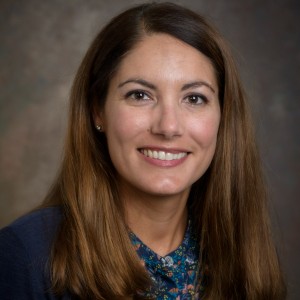
Aimee Jaramillo-Lambert
Education
- B.S. - University of California, Davis
- Ph.D. - University of California, Davis
- Postdoctoral - The George Washington University Medical Center
- Postdoctoral - National Institute for Diabetes and Digestive and Kidney Diseases, National Institutes of Health
Teaching
- BISC403: Genetics
- BISC400: Special Topics in Biology (Chromosome Structure and Function)
Research Interests
During sexual reproduction, haploid gametes (i.e. eggs and sperm) are generated from diploid precursors through the specialized cell division of meiosis. Meiosis reduces ploidy by following one round of DNA replication with two rounds of chromosome segregation (Meiosis I and Meiosis II respectively). In Meiosis I homologous chromosomes separate, which requires pairing, synapsis, and recombination. In Meiosis II sister chromatids segregate from each other similarly to mitosis. Meiotic events must be tightly regulated to ensure the accurate segregation of chromosomes. Problems in chromosome segregation can compromise basic cellular functions leading to infertility, progeny inviability, birth defects, and cancer.
Current Projects
We utilize the unique structural organization of the C. elegans germ line to study sex-specific differences in the specialized cell division of meiosis (the cell division that makes sperm and eggs). Currently, we are focused on two main projects:
1) Identification of components required for the differential regulation of TOP-2 in male and female meiosis. Type II DNA topoisomerases (Topo II) are enzymes that play a crucial role in chromosome integrity by unknotting and untangling DNA. Topo II has mostly been studied in mitosis (the cell division that creates new cells for ordinary tissue growth). Due to their critical roles in mitosis, topoisomerases are important chemotherapy targets for cancer patients. Topo II is present in many different cells including cells that are undergoing the specialized cell division of meiosis. Much less is known about the role of Topo II in the meiotic cell cycle. We are using a combination of cell biology, live imaging, biochemistry, and proteomics to answer the following questions: 1) When and how does Topo II interact with the complex chromosome structure and proteins that are required to pair and segregate homologs (synaptonemal complex, recombination proteins, condensins, and cohesins)? and 2) How is Topo II regulated during both meiotic divisions?
2) Identification of the mechanisms that contribute to differences in meiotic chromosome structure in male and female meiosis. In both mitosis and meiosis DNA needs to be organized into chromosomes. In addition, these chromosomes need to be structured in a way that leads to their correct separation into daughter cells. As chromosomes prepare to separate, the chromatin compacts. Chromosome compaction during mitosis requires the action of condensin proteins and post-translational modifications of histone proteins. In meiotic prophase I, chromosome compaction is further complicated by the need to condense and restructure chromosomes in the context of a homologous partner. In several organisms both chromosome size and nuclear volume has been found to be greatly reduced in spermatogenesis compared to oogenesis. We are using a targeted candidate gene approach and a genetic screening strategy to identify novel genes that differentially regulate chromosome compaction in spermatogenesis and oogenesis.

